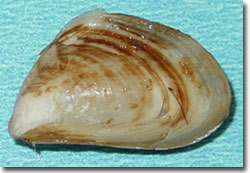By Alice Rossignol and Rachael Gleason
At first, it seemed like the two water-cloggers were playing nice. But one of the lake invaders prevailed in the end. Was it the thick and slimy Eurasian Invasion? Or the highly adaptable and shielded Quagmeister?
The winner is…

Quagga "The Quagmeister" Mussel. Photo: USGS.
THE QUAGMEISTER
The mussel had overwhelming crowd support. Ninety percent of readers who voted in the lake fight poll put their money on the Quagmeister.
A third of those who filled out brackets guessed the water-filterer would win Round 2, and about 13 percent are still in the running to win a SmackDown! prize.
But like the last semi-finals battle, the science isn’t clear. In many ways, the Eurasian Invasion and the Quagmeister complement each other.
Aquatic plants can provide a foothold for mussel invasion, said David Kelch, associate professor and sea grant extension specialist with Ohio State University’s Sea Grant College Program.
Mussels are able to attach to plants like the Eurasian watermilfoil. Trailer hitches and boats sometimes unknowingly transfer the slimy vegetation – and mussels – to other bodies of water, Kelch said.
But it’s quagga mussels that really pave the way for more lake invaders.
“They filter the water and make it clearer, which is one reason we’ve had a huge increase in aquatic plants in the Lake Erie – because they increase water filtration and water quality,” Kelch said.
The Ohio Sea Grant program has a laboratory at Put-in-Bay in western Lake Erie. The bay was weed free before zebra and quagga mussels came along, Kelch said.
“Water was turbid with a lot of algae. Sunlight couldn’t get to the bottom and provide sun for plants to grow,” he said. “After zebra and quagga mussels, there was an explosion of vegetation at the bottom of the bay. Now they have to use underwater mowers to clear areas.”
The increased vegetation is a thriving habitat for some species of fish – good and bad, Kelch said.
That’s why the Quagmeister is moving onto the finals; there are thousands of them, and they impact all levels of the food chain.
“If you look at the number of quagga mussels at the bottom of Lake Erie, we’re talking 100,000-plus filtering water every day. That’s a tremendous amount of potential impact,” Kelch said. “The impact to an inland lake is much greater.”
Can the Quagmeister take down the blood-sucking sea lamprey in the SmackDown! finals? Stay tuned for the championship round.
Pingback: Great Lakes SmackDown! | Great Lakes Echo